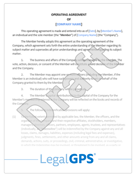Should You Trademark Your Company Name? A Complete Guide
Registering your company name as a trademark can be a significant step in protecting your brand. But is it always necessary? Let’s break down what...
3 min read
LegalGPS : Oct. 14, 2024
If you conduct most of your business through your website, adding a copyright notice is crucial. Not only does it deter infringement, but it also strengthens your legal position if someone uses your content without permission. Let’s break down what a copyright notice is, why it matters, and how to do it right.


Legal GPS Pro
Protect your business with our complete legal subscription service, designed by top startup attorneys.
A copyright notice is a way to inform the public that you own the content published on your website. You’ve probably seen it before—the letter “C” inside a circle (©), followed by the year and the owner’s name. For example:
© 2024 Legal GPS Inc.
Originally, copyright notices were mandatory in the U.S. until 1989, but today, thanks to the Berne Convention, works are automatically protected once they’re fixed in a tangible form. Even though a copyright notice isn’t required, there are significant benefits to including one.
A copyright notice makes it clear that the content on your website is protected. This discourages others from copying or reproducing your work, either knowingly or unknowingly. Think of it as a visible reminder that your work is legally protected.
If someone infringes on your copyright despite the notice, having it strengthens your case if you decide to take legal action. Defendants can’t claim ignorance since the notice makes it obvious that the material is protected. This could be especially important if you need to sue outside of the countries covered by the Berne Convention.
A copyright notice clearly establishes your ownership of the content. This can be particularly useful if someone challenges your rights to the material. Having your name and the date associated with the work creates a record of ownership that is easy to verify.
Protect Your Business With IP Rights
A proper copyright notice typically has three elements:
The Copyright Symbol: The most recognizable option is ©, but you can also use “Copyright” or “Copr.” It’s best to stick with © for clarity.
Year of Publication: This indicates when the content was published. If your website has content spanning multiple years, use a range, such as “2015-2024.” This way, all your content is covered.
Owner’s Name: The name can be your personal name, your business name, or even a pseudonym—just make sure it clearly designates who owns the rights.
Optionally, you can add a rights statement, such as “All Rights Reserved” or “Some Rights Reserved,” to specify the extent of your copyright.
Example: “© 2024 Your Business Name. All Rights Reserved.” This tells visitors that you retain all rights to the content and that they cannot use it without your permission.
Place your copyright notice in a visible location, typically in the footer of your website. This ensures that it appears on every page, making it easy for users to see. If the notice is easy to locate, it’s more likely to deter infringement.
You can add a copyright notice at any time, but it’s best to include it as soon as you publish any new content. This way, your work is protected right from the start. Make it a habit to update the copyright year whenever you add new content or make significant updates to your site.


Legal GPS Pro
Protect your business with our complete legal subscription service, designed by top startup attorneys.
Make sure your notice includes the copyright symbol, year, and owner’s name. Missing any of these could weaken your claim if you need to take legal action.
Always update the year to reflect the latest publication date. An incorrect or outdated year can leave some of your content unprotected, especially newer additions to your site.
The notice should be easy to locate. If users can’t see it, it may not provide adequate protection. Stick to placing it in the footer or any prominent, consistent spot across your website.
A copyright notice protects any material that can be seen or perceived by users, including:
Textual Works: Blog posts, articles, and written content.
Visual Art: Photos, illustrations, and graphic designs.
Performing Arts: Videos, sound recordings, and music.
Source Code: HTML, CSS, and other website code, as long as it’s in a fixed form.
Note: Not everything on your website may be copyrighted. Functional design elements, common layouts, and other non-unique features aren’t eligible for copyright protection.
© 2024 Your Business Name. All Rights Reserved.
© 2018-2024 Your Website. Some Rights Reserved.
© 2024 Your Name. No Rights Reserved.
These examples show how you can customize the notice based on your needs.
While adding a copyright notice isn’t mandatory, it’s a simple and effective way to protect your website content. It informs users, deters potential infringers, and strengthens your legal position if someone misuses your work. Take a few minutes to add a copyright notice to your website—it’s a small step that can make a big difference.
The biggest question now is, "Do I need a business lawyer?” For most businesses and in most cases, you don't need a lawyer to start your business. Instead, many business owners rely on Legal GPS Pro to help with legal issues.
Legal GPS Pro is your All-In-One Legal Toolkit for Businesses. Developed by top startup attorneys, Pro gives you access to 100+ expertly crafted templates including operating agreements, NDAs, and service agreements, and an interactive platform. All designed to protect your company and set it up for lasting success.

Legal GPS Pro
Protect your business with our complete legal subscription service, designed by top startup attorneys.

100+ legal templates, guides, and expert advice to protect your business.
Trusted by 1000+ businesses

Registering your company name as a trademark can be a significant step in protecting your brand. But is it always necessary? Let’s break down what...

1 min read
Whether you’re an entrepreneur, a creator, or running your own LLC, there’s a good chance you’ve produced something that qualifies for copyright...

You just finished a hard day’s work at the office. After commuting home and eating a quick dinner, nothing sounds better than some quality binge...